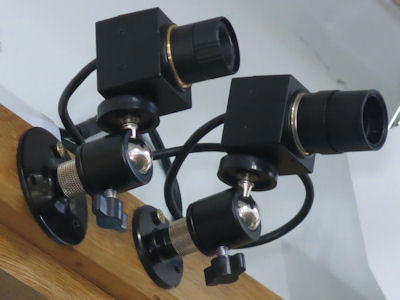
Cameras on swivel mounts over the door
Click images for larger view. Esc to return

Sam Hallas' Website

Cameras on swivel mounts over the door
Click images for larger view. Esc to return
All the presentation types require some sort of camera. There are different types with different connections and we tried many of them out at some stage in our development of the system.
First a note on video format: The format of widescreen television is pretty universally used in video streaming. The picture has an aspect ratio of 16:9 (wide:high). Standard sizes are 1080x1920 pixels for full high-definition (HD), known as 1080p; 720x1280 for ordinary HD (720p), 404x720 for lower definition, but smaller file sizes (704p). The smaller dimension is usually used to define the standard in use. 720p is a good compromise for streaming. (The "p" is for progressive scan, as opposed to "i" for interlaced but that doesn't concern us.) By using a full HD camera with 1080p output, but broadcasting at 720p we can use digital zoom to give close-up effects without changing the lens and without loss of quality.
We did some research on the internet to find out what other churches had used. Many web sites recommended Pan-Tilt_Zoom (PTZ) cameras. Others suggested camcorders or still cameras with a video output.
PTZ Cameras: A remote control allows the camera to be pointed at any required subject and the image zoomed in or out as required. Naturally this requires an operator to drive the camera during a service, so it scores low on simplicity of use. PTZ cameras are available with various interfaces, USB, HDMI, BNC video etc.
The provision of pre-set direction and zoom levels to allow a return to previously used settings would be useful provided by some models. Unless there is another camera available to switch to, it would be necessary to zoom during a live shot, which looks un-professional.
The Logitech PTZ Pro2 shown is one of the cheapest that came up in a web search. Most tended to be above £1000. Hence PTZ cameras fall outside of our 'shoestring' pricing need.
Webcams: The most obvious type of camera is the webcam designed to connect to a computer for use in video calling and conferencing. Most laptops have a built-in camera, but it is fixed in the lid and points at the user, making it unsuitable for broadcast purposes. All modern webcams claim at least 720p resolution.
External webcams plug into a USB socket on a computer. They range in price from under £10 to nearly £100. The quality and performance is in line with the price - from pretty basic to full high-definition and good low-light imaging. Cheap ones have plastic lenses while dearer ones have glass lenses, giving higher quality pictures.
Webcams are optimised for use in video calling and conferences. This means they work best at about a metre from the subject and have a fairly wide angle view. The view at a distance is adequate but not brilliant. The street view shown was taken with a Logitech C270, a popular webcam of a reputable brand that retails for about £25.
Mobile phones: Phones are equipped with very good cameras, but they have to connect to the computer over Wifi which can cause delay to the signal. A suitable app is Droidcam, which, as might be guessed, is for Android devices with a corresponding program to run on a laptop or PC. Even a cheap £30 Alba phone from Argos, as shown, produces a sharper picture than the webcam.
However, the need to set the phone up on a stand, switch it on before use and make the wifi connection with Droidcam tends to rule it out of consideration, being not simple enough. However, as a flexible standby for special occasions is can have its use for its wireless mobility.
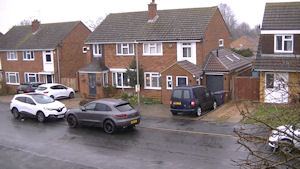
Street view with JVC Everio camcorder
Camcorder: Camcorders are in a different league in terms of performance and price. Their zoom lens allows a close-up shot even from the back of the Church. Typical prices for our application would be £200-300 new, or £50-100 second-hand. However camcorders don't normally connect direct to computers but use an HDMI interface via an interface converter.
The shot shown was taken of the same street view but at a later date and in different weather. Modern camcorders are capable of full HD at 1080x1920 pixels. Camcorders are battery operated and may not have the capacity to run for the length of whole church services without a charging lead connected. Some only produce the output signal continuously when switched to Record mode. Again the need to set the camera up and switch it on before use rules it out.
CCTV Camera: This type of camera is sold for industrial use or for security applications. Many have a USB connection allowing direct connection to a computer and many have a replaceable lens giving a choice of focal lengths and angle of view. An internet search found several similar, if not identical, cameras with different lenses. One with the brand name ELP and a 2-12mm zoom lens was chosen for trial. It has full HD resolution at 1080x1920 Pixels and was still available from Amazon for £66 in 2023.
We attempted streaming the candlelit carolservice on 20 December 2020. Only a normal webcam was available and the light level proved too low to give a satisfactory picture.
The first real test was brought by a request to stream a funeral service in January 2021. The equipment tried out was:
The results can be seen in the 57s clip below. Click the box in its bottom right to go full screen.
The opening view from the mobile phone is slightly fuzzy and sometimes a litle jerky, probably caused by low bandwidth on the Wifi link. The end section is clear enough but the slight loss of lip synchronisation is an artefact of the recording process. There was a problem with the Wifi link to the mobile phone at the end of the service as the image had frozen.
By the end of July 2021 we were confident enough to broadcast every week. The cameras in use changed in a search for the optimum. This clip from August 2021 uses in turn:
The opening shot shows the inherent problem with webcams which is that they are optimised for video conferencing and focus best at about arms length. The distanct scene is distinctly blurred. The middle shot is from the ELP CCTV camera with the 5-50mm lens supplied.
The conclusion was that the CCTV camera ticked all the boxes. Reasonably cheap, no setting up required, and excellent quality. USB connection plugs straight into the computer.
It became clear that we could not get by with just one CCTV camera as digitally zooming in to the lectern gave poor quality. So we bought another, but this time with a 2-12mm lens. The 5-50mm lens on the first camera had proved too touchy to zoom and focus on the lectern. The cure was to fit a fixed focus CS mount lens of 16mm focal length, which was an intelligent guess at what was required, but proved correct and only cost £10. The cameras were mounted discreetly above the entrance door giving a clear view of the front of the church using a gooseneck base, screw adapter, and ball head mount, costing about £11 for each camera, shown in the photo at the top of this page.
By November 2021 we had achieved most of the requirements listed on the previous page for views of:
The images below reveal what we judged as adequate quality except for the view of reader. There is some barrel distortion in the wide view, but that is tolerable for our purposes. The cameras produce good images in nearly all lighting conditions both daylight and artificial light. Adding a third camera for the reader is not as simple as it sounds - see later why it needs more hardware in the computer.
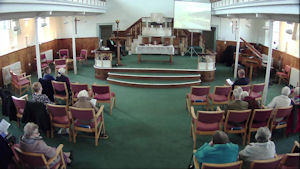
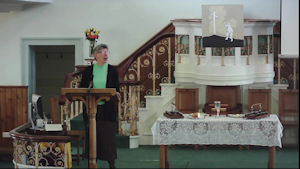
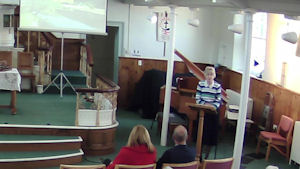
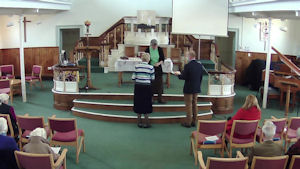
Next we'll look at the hardware and software needed for streaming services to the internet.
Part Three, Streaming (Hardware & Software)